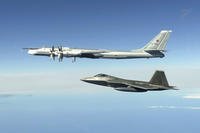
Here's a tip for the defense industry: If the Pentagon's top weapons buyer calls you in for a Saturday meeting, it's probably not to kick back and watch college hoops on one of the myriad high-def screens around the E-Ring.
This from the Wall Street Journal:
A multibillion-dollar Lockheed Martin Corp. contract to build a new fleet of Marine One helicopters for use by the president is in trouble, despite the company's efforts to keep the prestigious program on track.According to people familiar with the situation, John Young, the Pentagon's top weapons buyer, called for an unusual Saturday meeting with senior Lockheed officials to discuss the company's attempts at building 28 highly modified helicopters for White House use.
The contract, which started out at an estimated cost of $6.1 billion, has been plagued by early delays and engineering challenges, which would result in the program's running billions of dollars over budget if the Navy continues on its present course.
According to a senior Navy acquisitions official, the Navy commissioned three studies during the past year to examine potential alternatives. Canceling or severely cutting back the program are among the possible options being considered, say people familiar with the situation. In addition, officials have been looking at the possibility of asking United Technologies Corp.'s Sikorsky helicopter unit to step in with a version of its S-92 helicopter, which is the successor to the chopper that ferries the president on short trips. Versions of the S-92 are currently being used to carry a handful of foreign leaders, including the president of South Korea.
"There probably is no alternative that you could imagine that's not under consideration," said a senior Navy acquisitions official. Winning the plum contract in 2005 to build the Marine One fleet was a coup for Lockheed, which has been seeking in recent years to expand its defense business beyond its traditional core of building fighter jets and missiles.Lockheed and its European partner, Finmeccanica SA's AgustaWestland, defeated incumbent Sikorsky, which had been the favorite to win.
A Lockheed Martin spokesman said the company continues to "look at options with the Navy on how to proceed with the program."In December, the Navy ordered the Bethesda, Md., defense giant to stop work on the second portion of the contract, which called for Lockheed to build 23 of the 28 helicopters, citing budget issues. Work continues on the initial batch of five helicopters, which would enter service in 2009. The second batch of helicopters is slated to be more sophisticated and capable than the first five.
"We have now recognized based on the first three years of executing the program...that it's going to take more time and money" than originally anticipated to complete the second group of helicopters, the acquisitions official said.Lockheed and the Navy have been haggling for months about hundreds of design changes that the Navy has required since the contract was awarded. Many of the changes have been technically challenging and have resulted in adding performance-robbing weight to the helicopter. Officials acknowledge that costs have ballooned, but they say it's impossible to put an accurate figure on them until the program is restructured.
Young's reputation as a detail-oriented, no-nonsense administrator preceeded him into the AT&L position where he relieved Mike Wynne who in turn took over as Secretary of the Air Force. (Seems sort of incestuous, doesn't it?) In general, that's good for taxpayers, bad for sloppy defense firms.
(Gouge: NC)
-- Ward








